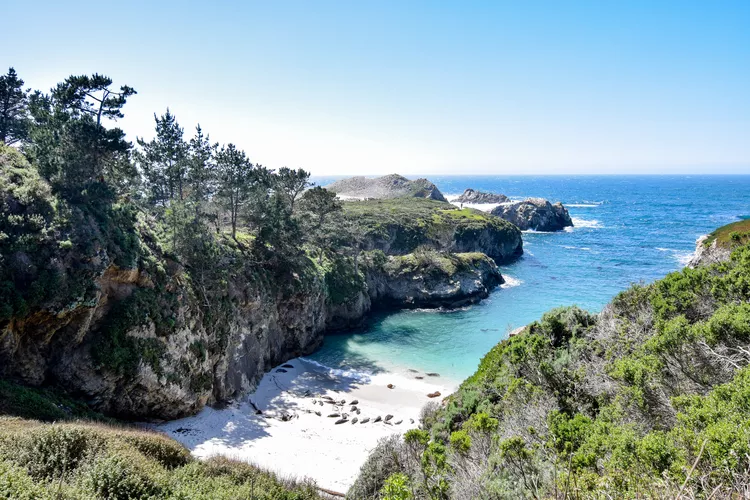Summary:
Exploring Point Lobos: Nature’s Gem on the California Coast
At Point Lobos, craggy rock formations plunge into the Monterey Bay, with ocean waves creating dramatic salt spray against them. A host of wild creatures make their homes in the ocean or on the shore, and you’ll find a rare stand of original-growth Monterey cypress trees at the point, one of only two such groves left in the world. On a clear day (or a cloudy one), it’s a little bit of heaven.
Tips for Visiting
- Waves can sneak up on you – and sturdy-looking cliffs can crumble unexpectedly. Therefore, stay on the trails and pay attention to your surroundings.
- You’ll find restrooms at Point Lobos, but no concessions. Consequently, if you plan to be there long enough to get hungry, bring food.
- Point Lobos serves as a nature preserve, not a playground. Activities you might enjoy elsewhere along the coast, such as Frisbee play, volleyball, and kite flying, are not allowed.
- Leave pets at home. Dogs (except certified service animals) are not allowed.
- No fires are permitted at any time, but you can picnic in the open areas where tables are available.
Diving Opportunities
Half of the Point Lobos reserve is under the water, making it a favorite spot for scuba diving and snorkeling. Diving is permitted only at Whalers and Bluefish Coves. You can get permission to dive when you enter, but you’ll need reservations, especially for weekends and holidays. Find out about diving at Point Lobos, including an online reservation form.
What You Need to Know
There is an entrance fee for the park, or you can park along the highway and walk in without paying. Nevertheless, it’s essential to do your part and pay if there’s room. Allow for at least an hour, but you could easily spend all day enjoying the natural beauty.
Point Lobos State Reserve
California Hwy 1
Carmel, CA
Point Lobos website
Point Lobos is situated just 3 miles south of Carmel on California Highway 1. Look for the entrance on the west side of the highway.
Whaler’s Cove
Half of Point Lobos State Reserve is under water, and the water between Whaler’s Cove and nearby Monastery Beach is one of two locations in the park where scuba diving is allowed. The cove got its name from its primary use in the late 1800s when it was part of a whaling station.
Harbor Seals
These harbor seals are resting on the rocks at China Cove, where you may also see egrets and watch sea otters floating in the kelp. Much smaller than the California sea lion, harbor seals are less graceful on land and almost always have spots. Their pups are born on the Point Lobos shoreline during April and May, and some areas may be off-limits at that time to give mothers and pups a stress-free environment.
Bird Island
You can probably guess how this island got its name, but these nesting birds aren’t the only creatures who live around Point Lobos. Harbor seals, Brandt’s Cormorants, Black Oystercatchers, Brown Pelicans, and sea lions are frequently seen. Moreover, you might even see a Gray Whale spouting as it passes during its migration (December through May).
Monterey Cypress
The Cypress Grove Trail is a 0.8-mile loop that leads through a unique area – one of only two naturally-growing stands of Monterey Cypress trees left on earth. The other stand is located across the bay at Cypress Point. Monterey cypress thrives in the foggy coastal environment and survives coastal winds that sculpt them into beautiful shapes.
Lace Lichen on the Cypress Grove Trail
You can find stringy-looking lichen on the Cypress Grove Trail and on the Lace Lichen Trail, which parallels the main road from the entrance into the park. The lace lichen, often mistaken for Spanish moss, takes up residence on dead branches without harming the tree. Lichens are cooperative organisms consisting of a fungus and algae, serving as indicators of good air quality.
Trentepohlia (Orange Pigmented Algae)
You’ll see a lot of this algae called Trentepohlia on the north side of the Allan Memorial Grove along the Cypress Grove Trail. Despite its velvet-like appearance, it has orange-colored chlorophyll. This plant rests on the tree limbs but does not harm them.
Cypress Grove at Sunset
While images capture Point Lobos’ beauty, the weather can vary greatly. It took the photographer four visits in six months to obtain clear skies and the perfect evening light. Therefore, for the best photo opportunities, plan a visit during spring or fall.
Famed photographer Edward Weston did much of his most beautiful work at Point Lobos in the 1930s. However, the preservation of this beautiful area is credited to A.M. Allan, who acquired the land before 1900. Point Lobos became a California state park in 1933.





